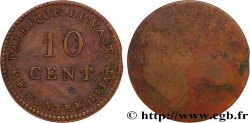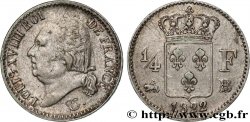fme_789902 - LOUIS XVIII Médaille du général La Fayette
200.00 €(Approx. 204.00$ | 168.00£)
Quantity
Add to your cart

Type : Médaille du général La Fayette
Date: 1824
Metal : bronze
Diameter : 46,5 mm
Orientation dies : 12 h.
Engraver CAUNOIS François Augustin (1787-1859)
Weight : 48,51 g.
Edge : lisse
Puncheon : sans poinçon
Coments on the condition:
Belle patine marron avec un reste de brillant. Présence de quelques marques d’usure sur les hauts reliefs, des coups sur la tranche
Catalogue references :
Obverse
Obverse legend : GENERAL - LAFAYETTE.
Obverse description : Buste du général La Fayette, en habit, à droite ; sur la tranche de l’épaule .1824. ; au-dessous signature CAUNOIS FRENCH..
Reverse
Reverse legend : THE DEFENDER / OF AMERICAN AND / FRENCH LIBERTY. / 1777-1824. / BORN IN CHAVANIAC, / THE 6 SEPTEMBER, / 1757..
Reverse description : Couronne de chêne, inscription au centre en sept lignes.
Commentary
Signature CAUNOIS FRENCH. au droit. Cette médaille a certainement été réalisée pour les États-Unis ; elle existe aussi en bronze doré ou en bronze argenté et en or.
Cette médaille commémore le voyage de La Fayette aux États-Unis le 13 juillet 1824. Collignon (La médaille au XIXe siècle et l’histoire) décrit ainsi ce voyage “Après avoir fait un triomphal accueil à Lafayette, qui était allé revoir le théâtre des exploits de sa jeunesse, le Congrès des États-Unis avait voté une résolution où il appelait Lafayette le champion de la liberté, le héros de la Révolution, l’ami et le compagnon de Washington, et il avait envoyé un navire de guerre le chercher en France. Le Vice-Président vint le recevoir à New-York. Il fut traité dans toutes les cités américaines avec les mêmes honneurs que s’il eut été le président d’une République Française. Les récits émouvants qui arrivaient d’Amérique apportèrent aux libéraux français une consolation, un encouragement et une espérance”. Lafayette effectue ce voyage avec son fils prénommé Georges Washington, 182 villes sont visitées entre 1824 et 1825. Le Congrès le remercie en lui faisant un don de 200.000 dollars (en récompense de l’argent qu’il avait avancé personnellement pour aider la Révolution américaine) et 12.000 hectares de terres en Floride. Il fut le premier étranger à s'adresser aux deux Chambres réunies du Congrès américain et son portrait figure dans la Chambre des Représentants. Il a été élevé à titre posthume, «citoyen d'honneur des États-Unis d'Amérique», un privilège rare qui n’a été accordé qu'à quatre reprises dans l'Histoire américaine.
Cette médaille commémore le voyage de La Fayette aux États-Unis le 13 juillet 1824. Collignon (La médaille au XIXe siècle et l’histoire) décrit ainsi ce voyage “Après avoir fait un triomphal accueil à Lafayette, qui était allé revoir le théâtre des exploits de sa jeunesse, le Congrès des États-Unis avait voté une résolution où il appelait Lafayette le champion de la liberté, le héros de la Révolution, l’ami et le compagnon de Washington, et il avait envoyé un navire de guerre le chercher en France. Le Vice-Président vint le recevoir à New-York. Il fut traité dans toutes les cités américaines avec les mêmes honneurs que s’il eut été le président d’une République Française. Les récits émouvants qui arrivaient d’Amérique apportèrent aux libéraux français une consolation, un encouragement et une espérance”. Lafayette effectue ce voyage avec son fils prénommé Georges Washington, 182 villes sont visitées entre 1824 et 1825. Le Congrès le remercie en lui faisant un don de 200.000 dollars (en récompense de l’argent qu’il avait avancé personnellement pour aider la Révolution américaine) et 12.000 hectares de terres en Floride. Il fut le premier étranger à s'adresser aux deux Chambres réunies du Congrès américain et son portrait figure dans la Chambre des Représentants. Il a été élevé à titre posthume, «citoyen d'honneur des États-Unis d'Amérique», un privilège rare qui n’a été accordé qu'à quatre reprises dans l'Histoire américaine.








 Report a mistake
Report a mistake Print the page
Print the page Share my selection
Share my selection Ask a question
Ask a question Consign / sell
Consign / sell
 Full data
Full data









